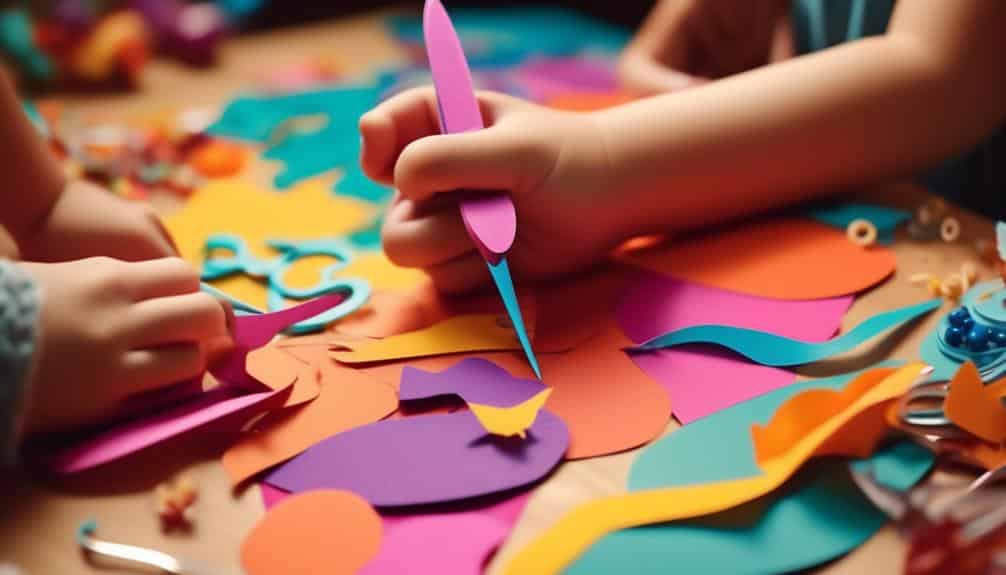Developing fine motor skills is crucial for kids’ early learning. Parents and educators are seeking fun ways to improve these skills. Dynamic fine motor skills activities, like drawing and playing with small objects, refine dexterity and hand-eye coordination. Traditional methods focused on repetition, but creativity and play are now emphasized. These engaging activities contribute significantly to the development of dynamic fine motor skills. Exploring how they enhance motor skills is essential for children’s growth.
Key Takeaways
- Fine motor skills development is crucial for everyday tasks and cognitive growth.
- Crafting with play-dough can strengthen hand and finger muscles and promote creativity.
- Artistic painting projects enhance precision, color exploration, and adaptability of brush techniques.
- Activities such as paint mixing, bead threading, scissor activities, and building play all contribute to developing fine motor skills.
Understanding Fine Motor Skills
Why are fine motor skills so critical for a child’s development? These skills, which involve precise hand and finger movements, are essential for everyday tasks ranging from buttoning a shirt to writing a sentence. Mastery of fine motor skills is a critical component of a child’s growth, underpinning their ability to perform self-care tasks, engage in playful exploration, and participate fully in educational activities. The small muscles in a child’s hands and fingers must be developed to gain the skill and strength necessary for hand-eye coordination.
Fine Motor Activities designed to nurture these skills can be enjoyable and educational. Simple yet effective Fine Motor Activities include threading beads onto a string, which enhances hand-eye coordination, and sorting objects by size or color, which refines precision and cognitive skills. Puzzles and play-dough tasks entertain and challenge children to manipulate objects carefully and intentionally.
Developing the pincer grasp, where a child uses their thumb and forefinger to pick up small items, is a fundamental Fine Motor Activity that lays the groundwork for writing and other academic pursuits. Regularly engaging in fine motor skills activities is critical to fostering a child’s independence, cognitive development, and readiness for future educational challenges.
Crafting With Play-dough
Engaging in play-dough crafts, children hone their fine motor skills through the creative process of kneading, rolling, and sculpting this pliable material. As little hands press and shape the dough, they express their imagination and strengthen the muscles and coordination required for more intricate tasks. Crafting with play-dough is an activity that serves multiple developmental purposes, benefiting children in an enjoyable and tactile way.
Here is why crafting with play-dough is so beneficial:
- Strengthens Hand and Finger Muscles: Manipulating play dough helps to develop hand and finger strength, which is crucial for writing and scissors.
- Promotes Imagination and Creativity: Children can create a vast array of shapes and objects, which fosters their creativity and ability to envision and execute a plan.
- Improves Hand-Eye Coordination: As children shape the play dough, the coordination between what they see and how they move their hands is enhanced.
- Enhances Sensory Skills: The sensory experience of touching and molding play-dough can aid in developing sensory processing abilities.
Artistic Painting Projects

Moving artistic painting projects are enjoyable and instrumental in refining a child’s fine motor skills. Children learn to maneuver and control the brush through creative brush techniques, enhancing their precision and grip strength. Additionally, paint mixing allows for exploring color and texture, which fosters cognitive development and the talent needed for tasks like stirring and pouring.
Creative Brush Techniques
Exploring creative brush techniques through artistic painting projects offers children a playful avenue to enhance their fine motor skills and artistic aptitude. Encourage your child to delve into the world of art with these engaging activities to develop their abilities:
- Use a variety of brush sizes and shapes to create different textures, promoting adaptability and precision in their movements.
- Experiment with color blending to foster hand-eye coordination and an understanding of color theory.
- Introduce stippling, splattering, and dry brushing to expand their repertoire of fine motor skill activities.
- Incorporate unconventional tools like leaves, feathers, or sponges for a tactile experience that stimulates creativity and sensory exploration.
These types of painting exercises not only build artistic skills but also bolster children’s confidence in using their hands to express themselves.
Paint Mixing Exploration
Delving into paint mixing can open a world of color possibilities for young artists, enhancing their understanding of hues while refining their fine motor skills. This activity not only sparks creativity but also helps improve coordination and control. Using various tools such as brushes, sponges, and even their fingers, little ones engage in sensory play that is critical for their development.
As children combine colors to see new shades emerge, they learn about color theory and the exciting process of making different shapes on their canvas through paint mixing exploration. Introducing them to blending techniques and color gradients further enriches their artistic journey. This hands-on experience is invaluable in developing the skills necessary for more intricate tasks in the future.
Interactive Bead Threading
Interactive Bead Threading is a dynamic activity that enables children to enhance their fine motor skills and hand-eye coordination by threading various-sized beads onto strings or laces. This engaging task not only captivates children’s interest but also serves as an excellent tool for educators and parents to help strengthen the skills of little hands.
Here are four key benefits of Interactive Bead Threading for children:
- Develops Precision: Handling different items like beads of various sizes improves fine motor control and precision in finger movements.
- Promotes Hand-Eye Coordination: As children thread beads onto laces, they learn to coordinate the movements of their hands with what their eyes see.
- Encourages Progression: Starting with larger beads and moving to smaller ones offers a gradual challenge that keeps children motivated and shows visible progression in their skills.
- Fosters Concentration: The focus required to complete bead threading tasks can enhance a child’s concentration and patience, which are valuable skills for academic learning.
Engaging Scissor Activities

Moving on to scissor activities, it’s crucial to introduce children to the correct use of scissors to enhance their fine motor skills and ensure safety. Starting with basic snips and gradually progressing to more complex shapes helps children develop precision and coordination. Always prioritize safety by providing child-safe scissors and close supervision during cutting tasks.
Scissor Skill Progression
Mastering scissors is a fundamental step in enhancing a child’s fine motor skills, and various engaging activities can facilitate this progression. Here are some practical activities that help develop scissors skills in children:
- Cutting Play-Dough: Children can practice cutting different shapes using fine motor skills, such as toys like play-dough scissors, which improve fine motor coordination.
- Paper Strips Snipping: Begin with simple snips on paper strips to build fine motor skills before progressing to more complex shapes.
- Collage Creation: Encourage activities for preschoolers that require fine motor precision, such as cutting out pictures from magazines to create a collage.
- Craft Projects: Design craft projects that involve cutting various materials and helping children refine their scissor skill progression while making art.
Safety Tips First
While engaging children in activities that develop their scissor skills is essential, it is equally important to prioritize safety measures to ensure a secure learning environment. Introducing scissors should have clear guidelines: use child-safe scissors that fit the child’s hand comfortably, offer direct supervision, and establish rules for scissor use. When practicing cutting along lines to improve fine motor control and hand strength, ensure that the activity area is free from distractions and clutter.
Emphasize the importance of cutting away from the body and keeping fingers away from the blades. Regularly inspect scissors for damage to prevent accidents. By placing safety tips first, we create a foundation for children to safely explore the best fine motor activities and support their overall motor development.
Building and Construction Play
Delving into Building and Construction Play, children can significantly enhance their fine motor skills by engaging in activities such as stacking blocks and assembling Lego pieces. This hands-on approach to learning captivates young learners’ attention and offers many developmental benefits.
Here’s how building and construction activities can foster fine motor development in children:
- Block Play: Preschoolers refine their motor coordination and control by stacking and organizing blocks, laying a foundation for more complex skills.
- Lego Construction: Assembling Lego pieces demands precision and skill, reinforcing the pincer grasp crucial for writing.
- Loose Parts Creation: Engaging with a variety of materials, including buttons and beads, children explore different textures and shapes, enhancing their tactile experiences and fine motor abilities.
- Woodwork Projects: Simple tasks like hammering nails into wood build strength and improve hand-eye coordination.
Integrating items like toothpicks, matches, and even pipe cleaners into motor activities can add a layer of challenge and creativity. Encouraging children to manipulate these different objects helps them master the fine-tuned movements needed for daily tasks, ensuring they develop fine motor skills.
Frequently Asked Questions
What Activities Improve a Child’s Dynamic Fine Motor Skills?
Activities that enhance a child’s fine motor skills include a sticker and stringing exercises, paper-tearing crafts, coin sorting, and manipulating clothespins, all designed to develop grip strength and hand-eye coordination.
How Can I Help My Child With Poor Fine Motor Skills?
Engage children in tailored tasks incrementally, challenging their fine motor abilities to nurture their talent. For example, manipulating play dough fosters muscle development and coordination in a playful, supportive environment.
Do Legos Help With Fine Motor Skills?
Yes, Legos are beneficial for enhancing fine motor skills. They require precise hand movements and agility, crucial for developing hand-eye coordination, pincer grasp, and overall manual dexterity in children.
What Is a Good Fine Motor Skill Activity for a 6-Year-Old?
For a 6-year-old, creating an intricate string of Cheerios jewelry can be a delightful challenge. It fosters hand-eye coordination and dexterity while offering a tangible reward for their patience and fine motor skill development.
Conclusion
Fine motor skills are vital to children’s physical and cognitive development. These skills enable children to perform everyday tasks, from simple to complex, and enhance their ability to learn and perform well in school. Motor activities such as finger painting, construction play, and using tools like scissors and pipe cleaners promote the development of motor control, grip strength, and muscle memory. Occupational therapists use motor skill development to help children achieve developmental milestones and improve their quality of life.
Children develop motor abilities during infancy, including grip strength, finger isolation, and precise movements. As infants progress through developmental stages, they improve their posture control and increase their grip strength. Children can practice their motor skills by engaging in various age-appropriate toys and activities, such as the Penguin and Snowman Therapy Kits. These activities improve children’s cognitive and sensory development, including perceptual skills, spatial awareness, and eye-hand coordination.
As children grow, they continue to develop their motor skills through practice and exploration. Activities that promote manual dexterity, such as cutting paper and handwriting, enhance their ability to perform intricate tasks. Children can improve their problem-solving, math, and language skills by practicing complex skills like the pincer grip and bilateral coordination. The Cutting Practice Station is an excellent learning activity that helps children enhance their motor skills and proper handwriting.
In conclusion, enhancing fine motor skills is essential in childhood education. Motor skill activities promote physical and cognitive development, enhance social skills, and improve the quality of life. Children can develop precise hand movements, core strength, and postural control by engaging in fun activities that provide sensory input. These activities, proper education, measurement tools, and DIRFloortime therapy help children acquire and maintain competent motor skills.


Recent Comments